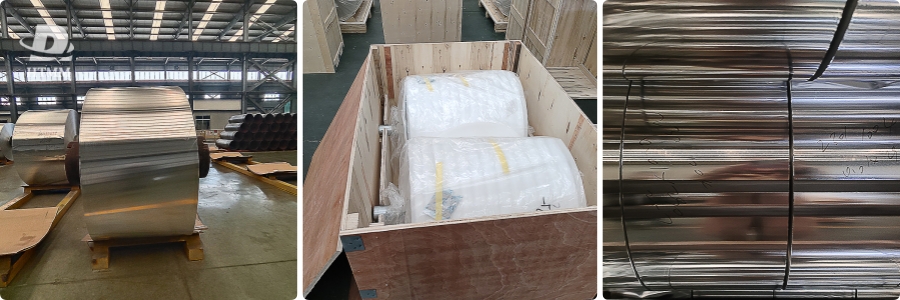Aluminum foil is a versatile material used in food packaging, household products, and industrial applications. With the advancement of aluminum foil rolling technology, thinner and higher quality aluminum foils have been manufactured to meet different needs. This article focuses on a special type of aluminum foil - China 6 35Mic 8079 Ho aluminum foil. 
What is 8079 aluminum alloy?
8079 aluminum alloy is a heat-treatable alloy in the 8xxx series (8xxx refers to an alloy mainly composed of aluminum and copper). Alloy 8079 contains approximately 95% aluminum, 4% copper, 0.15% manganese and other trace elements. Adding copper to aluminum significantly increases its strength while maintaining density and workability. Alloy 8079 exhibits extremely high tensile strengths of up to 420 MPa after heat treatment. It also has excellent corrosion resistance due to the thin oxide layer formed on the surface.
These properties make 8079 aluminum alloy suitable for applications requiring strength and durability, even in thin gauge applications such as beverage cans, bottle caps and packaging foils. The key properties that make Alloy 8079 the material of choice for aluminum foil are:
High tensile strength to withstand handling and processing stress
Capable of producing ultra-thin foils below 10 microns
Resistance to denting and bending during packaging and shipping
Barrier properties due to low gas/moisture vapor permeability
Corrosion-resistant, extending the shelf life of packaged products
Recyclability at end of product life
What is 6.35 micron/6.5 micron aluminum foil?
The thickness or gauge of aluminum foil is usually measured in microns. One micron is equal to one millionth of a meter, often written as μm or u. When aluminum foil thickness is described as 6.35 microns or 6.5 microns, this means that the average thickness of the foil is 6,350 nanometers or 6,500 nanometers respectively.
Having such a low micron rating makes the foil very thin yet functional. Sub-10 micron foils can provide barrier and packaging performance while maintaining flexibility. They are suitable for applications requiring very thin but strong packaging materials.
Some of the key benefits of using 6.35/6.5 micron grade foil include:
Made of 8079 alloy, ultra-thin but high strength
Excellent gas, moisture, and bacteria barrier properties due to extremely low permeability in thin gauges
Lightweight packaging – reducing material costs and carbon footprint
Can be molded and suitable for various packaging styles
Heat reflective properties aid food preservation
Thanks to the smooth surface, clear printing and designs can be applied
By carefully calibrating the mill, manufacturers can produce aluminum foil closest to the target 6.35/6.5 micron thickness grade with less deviation, ensuring consistency across large batches. Proper quality inspection can also minimize defects and waste.
How is aluminum foil made?
The aluminum foil manufacturing process consists of several steps:
Alloying: High-purity aluminum ingots are melted and alloyed with other elements such as copper to specific alloy specifications.
Casting and Homogenization: Molten aluminum alloy is continuously cast into coils using a twin-roll casting machine. The coil is then slowly heated and cooled to homogenize the microstructure.
Hot rolling: The cast coil passes through a hot rolling mill and is rolled multiple times to reduce the thickness. This process improves the grain structure.
Cold Rolling: The thickness is further reduced to less than 100 microns by high pressure cold rolling to achieve the required specifications. Use lubricant.
Annealing: The cold-rolled foil passes through an annealing furnace to eliminate internal stress and reorient the grain structure.
Face Rolling: Light rolling imparts strength and surface smoothness.
Slitting and Rewinding: Cutting wide foil into narrower roll widths based on customer demand.
Quality inspection: regularly conduct thickness, surface, and adhesion tests on samples.
Packaging: Aluminum foil rolls are packaged, labeled and stacked on pallets for shipping.
By leveraging advanced technology, manufacturers can produce 6.35/6.5 micron foils through a tightly controlled process. Automated measurements ensure consistency throughout the entire high-speed rolling operation.
6.35Mic 8079 aluminum foil performance and application
Strength: Alloy 8079 combined with an optimized annealing process gives thin gauge foils a tensile strength of 200-250 MPa. This allows them to maintain shape integrity during handling, filling, and sealing applications.
Barrier Properties: The foil is only 6.35 microns thick, providing excellent barrier properties to gases such as oxygen, moisture, aroma/fragrance and more. This protects packaged foods from degradation and contamination.
Thermal Reflection: Thin foils have high emissivity and help reflect more than 90% of thermal radiation. They help food preservation by slowing the transfer of heat.
Other uses:
Decorative foil for gift packaging and stationery
thermal management foil
Insulating foil for pipes and storage tanks
Moisture proof layer in building
With its advantages in different usage scenarios, 6.35 micron 8079 aluminum foil has become an excellent solution for manufacturers in various industries around the world. Its combination of functional properties, processability and recycling potential increases its popularity.
6.35 Microphone 8079 Aluminum Foil China Supplier
China is the world's main supplier of aluminum foil, accounting for more than 35% of the world's total aluminum foil production. Several well-known Chinese manufacturers specialize in 6.35/6.5 micron grade 8079 alloy foil.
Market dynamics and future prospects
The global aluminum foil market size was US$18 billion in 2019, and is expected to grow at a compound annual growth rate of 5.2% from 2020 to 2027. Growth is driven by growing demand from food packaging and other industrial segments. Among them, thinner grades such as 6.35 micron aluminum foil are gaining attention due to their excellent barrier properties and lightweight properties.
Emerging opportunities lie in new applications such as agricultural foil packaging, flexible electronics and aerospace insulation blankets. Manufacturers are focusing on advanced rolling technologies to commercially achieve sub-6 micron specifications. Development of high-performance surface treatments and alloys is also ongoing.
In summary, 6.35 micron thick 8079 aluminum foil is the best solution when ultra-thin, high-strength packaging films are required. Stable supply from Chinese manufacturers coupled with its diverse functional properties drive its global use. Growing demand across multiple industries indicates a bright future for this special grade of aluminum foil.

